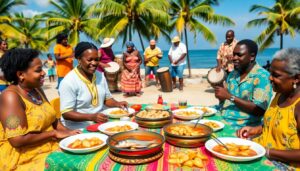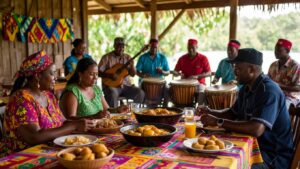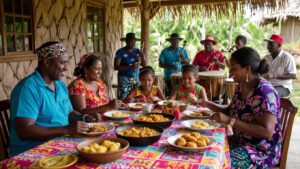Unveiling the Vibrant Garifuna Culture in Belize: A Journey Through Heritage, Culinary Wonders, and Cultural Experiences
The Garifuna people of Belize epitomise a dynamic blend of African, Indigenous Caribbean, and European cultural influences, crafting a distinctive cultural heritage that enjoys global recognition, particularly from UNESCO. Their vibrant traditions span various domains including language, music, culinary arts, dance, spirituality, and a robust sense of community. This comprehensive guide offers an in-depth exploration of the enthralling narrative of the Garifuna in Belize, examining their history, traditions, festivals, cuisine, and the lively cultural hub of Hopkins Village.
Delving Deep Into the Garifuna Heritage
The Garifuna are recognised as one of the most prominent cultural groups in Belize, with their lineage tracing back to West and Central African ancestors, alongside the Indigenous Caribs and Arawaks. After bravely resisting colonial oppression in St. Vincent in 1797, they were forcibly relocated to Central America. Today, the Garifuna population in Belize stands at around 30,000, playing a vital role in the cultural fabric of southern Belize through their distinctive language, scrumptious cuisine, lively art, and rich customs. Their resilient spirit, creativity, and adaptability thrive in communities like Dangriga, Hopkins, Seine Bight, and Punta Gorda, as well as in diaspora communities across the Americas. The annual celebration of Garifuna Settlement Day on November 19th serves as a poignant reminder of their enduring story of resilience, community, and rich cultural traditions.

Unearthing the Historical Origins of the Garifuna People
Connecting the Dots of African and Carib Ancestry
The story of the Garifuna people begins in the 17th century with the extraordinary convergence of African survivors from two Spanish slave ships and the Indigenous Carib and Arawak inhabitants of St. Vincent in the Lesser Antilles. Over a period exceeding 150 years, intermarriage and cultural exchanges birthed a unique Afro-Indigenous identity known as the Garinagu. This identity is characterised by a rich tapestry of traditions, languages, and practices that reflect their diverse ancestral backgrounds, showcasing their resilience and adaptability.
Forced Migration and New Beginnings in Belize
In 1797, in the wake of fierce opposition to British colonial forces, approximately 5,000 Garifuna were forcibly displaced from St. Vincent to Roatán, Honduras. This marked the onset of migrations that would propagate along the Central American coastline. By the early 19th century, flourishing Garifuna communities had taken root in southern Belize, particularly in culturally significant locales such as Dangriga, often referred to as the cultural capital, Hopkins, Seine Bight, and Barranco. British authorities facilitated these migrations, seeking skilled labourers adept in fishing and agriculture, which contributed to the establishment and growth of these vibrant communities.
Cultural Resilience and Continuity Through Adversity
Despite the myriad challenges posed by European colonisation, land dispossession, and systemic discrimination, the Garifuna have remarkably preserved their language, social institutions, and rich spiritual traditions. The establishment of the National Garifuna Council in 1981 has been instrumental in advocating for cultural rights and education, ensuring that the Garifuna heritage continues to be celebrated and acknowledged both locally and internationally.
The Vital Role of Language and Identity in Garifuna Culture
The Distinctiveness of the Garifuna Language
The Garifuna language is an Arawakan language that stands out due to its incorporation of Carib and African loanwords, making it a remarkable representation among Central American languages. It boasts gendered pronouns, a complex tense system, and a wealth of oral traditions that encapsulate the community’s history and cultural values. However, the survival of the Garifuna language is currently under threat due to language shift prompted by migration and urbanisation, with fewer than 15,000 Belizean Garifuna individuals remaining fully fluent.
Initiatives for Revitalisation and Preservation
The recognition of the Garifuna language and music as Intangible Heritage by UNESCO in 2001 has sparked revitalisation efforts across various communities. In places like Hopkins and Dangriga, primary schools have begun offering educational programs in Garifuna, while local radio stations broadcast news and music in the language, helping keep it vibrant. Initiatives by organisations such as GAMAE International have launched language immersion summer camps aimed at reconnecting youth with their ancestral roots and linguistic heritage, fostering a sense of identity and belonging.
Expressions of Identity and Global Diaspora Connections
The Garifuna identity is reinforced through traditional attire, ancestral lineage, clan totems, and unique naming customs. This identity is actively cultivated by cultural associations both within Belize and in diaspora communities found in major cities like New York, Los Angeles, and London, where they consistently celebrate and honour their rich heritage.
The Lively Realm of Garifuna Music and Dance
Intricate Drumming and Spiritual Significance
Garifuna music is renowned for its complex rhythmic patterns, which seamlessly blend traditional African polyrhythms with indigenous chants. Drumming, especially with the primero (tenor) and segunda (bass), is central to many spiritual rituals and festive occasions. The sacred dugú ceremony, for example, involves communal drum circles and ancestral invocations aimed at healing or blessing families, exemplifying the profound connection between music and spirituality in Garifuna culture.
The Dynamic Dance Styles of Punta and Punta Rock
One of the most celebrated dance forms within the Garifuna culture is the punta, characterised by rapid hip movements and intricate footwork, often accompanied by call-and-response singing and vibrant percussion rhythms. The contemporary evolution of this dance style, referred to as punta rock, has gained popularity through the works of renowned musicians like Andy Palacio and Pen Cayetano, who merge traditional rhythms with modern instrumentation, effectively spreading Garifuna culture to audiences worldwide.
Cultural Festivals and Community Celebrations
In the lively towns of Hopkins and Dangriga, dance troupes frequently perform during cultural festivals and for visiting tourists, forging a living connection across generations. These performances not only celebrate the rich heritage of the Garifuna but also serve as a significant economic resource for the community, fostering tourism and cultural exchange.

Diving Into Garifuna Cultural Practices and Spiritual Beliefs
The Importance of the Dugú Ceremony
The dugú ceremony is a significant multi-day event where extended families gather to honour the spirits of their ancestors, known as gubida. Under the guidance of a spiritual healer, or buyei, the ceremony incorporates music, dance, and communal feasting, all aimed at restoring harmony within families and the larger community. This ritual emphasises a deep respect for the land, ancestral heritage, and collective responsibilities towards one another.
Day-to-Day Life and Spiritual Beliefs of the Garifuna
The spiritual beliefs of the Garifuna represent a unique blend of Catholicism alongside African and Arawak cosmologies. Daily life is punctuated by various rituals, which encompass blessings for new structures, rites of passage for births and deaths, as well as agricultural celebrations. Key symbols such as the conch shell, sea turtle, and cassava serve as vital connections between households, the natural world, and ancestral spirits.
Gastronomic Delights: Exploring Garifuna Cuisine
Core Ingredients and Signature Dishes
The culinary landscape of Garifuna culture is deeply rooted in staples such as cassava (or yuca), plantains, coconut, and fresh seafood. Notable traditional offerings include ereba, a cassava bread crafted from grated cassava that is pressed and toasted over an open flame. Another hallmark dish, hudut, features fish simmered in creamy coconut milk, served alongside mashed green and ripe plantains. Machuca, a hearty fish soup with garlicky, mashed plantain dumplings, and tapou, a savoury coconut milk seafood stew, are also widely enjoyed. In bustling street markets in Hopkins and Dangriga, visitors can indulge in local delights like cassava pone (a sweet cake), fried plantain balls (known as ganún), and refreshing conch ceviche.
Championing Sustainable Culinary Practices
Traditional Garifuna practices such as seasonal fishing, shellfish gathering, and small-scale gardening actively promote ecological stewardship. These practices adhere to cultural taboos and principles of communal resource management. Culinary festivals held in Hopkins spotlight cooking contests and food tours facilitated by women’s cooperatives, ensuring the preservation of cherished recipes and culinary techniques while inviting visitors to engage with the rich gastronomic heritage of the Garifuna.
Hopkins Village: The Cultural Heartbeat of the Garifuna
Historical Context and Cultural Significance
Established in the early 1800s and known as Yarumein in Garifuna, Hopkins is nestled along the stunning Stann Creek coast. It serves as a crucial hub for the Garifuna language, music, and crafts, embodying the vibrant cultural legacy of the community.
Essential Experiences to Explore in Hopkins
- Drum Circles: Engage in daily drum schools and relish nightly drum circles at local cultural centres.
- Garifuna Museum: Discover artifacts, oral histories, and photographic archives that delve into migration, language, and music.
- Homestays and Workshops: Connect with local families who provide cooking lessons, fishing excursions, and demonstrations of cassava bread making.
Annual cultural events in Hopkins, especially the youth pageants during Garifuna Settlement Day, position the village as an authentic gateway to experiencing the intricate cultural tapestry of Garifuna Belize.
The Economic Impact of Cultural Tourism
Cultural tourism is integral to the economy of Hopkins, supporting over 75% of local households through guest lodgings, handicrafts, music classes, and guided tours. The headquarters of the National Garifuna Council oversees regional festivals and advocacy initiatives, ensuring that Garifuna culture remains vibrant and visible for generations to come.
Commemorating Garifuna Settlement Day: A Cultural Celebration
The Historical Importance of Settlement Day
Observed each November 19 since 1941 and nationally acknowledged since 1977, Garifuna Settlement Day commemorates the significant arrival of Garifuna ancestors in Belize by canoe in 1802. The reenactment procession known as Yurumein sees villagers arrive ashore carrying drums, cassava, and crops amidst joyous singing and prayer, symbolising their enduring legacy and cultural heritage.
Contemporary Celebrations and Festivities
The festivities surrounding Garifuna Settlement Day are a beautiful fusion of sacred and secular elements, featuring overnight dugú ceremonies and continuous drumming in churches and community squares. Processions adorned in traditional attire, lively parades, dance performances, and food fairs characterise the celebrations. National broadcasts, media coverage, and diaspora events in major US cities attract visitors from across Belize and beyond, enhancing awareness and appreciation of Garifuna cultural traditions.
Navigating Modern Challenges and Sustaining Cultural Heritage
The Language Shift Among Younger Generations
The challenge of language shift poses a significant threat to the Garifuna community, as many young individuals, particularly in urban settings, are increasingly adopting English or Kriol as their primary language at home. UNESCO has acknowledged this alarming trend, leading schools and NGOs to implement language immersion programs, radio broadcasts, and mentorship efforts to safeguard linguistic heritage and cultural identity.
Land Rights Challenges and Tourism Development
The rapid growth of tourism and real estate development in coastal regions like Seine Bight and Hopkins jeopardises the traditional landholdings of the Garifuna. Advocacy from the National Garifuna Council and collaborative NGOs is crucial in securing land rights, influencing urban planning, and ensuring that tourism revenues directly benefit local families and communities.
Engaging Youth Through Arts, Technology, and Diaspora Connections
Garifuna artists and musicians, both locally and in the diaspora, are actively documenting music, recipes, and oral histories to create digital archives and virtual festivals. These contemporary platforms are essential in building relationships between the broader Garifuna community and younger generations, ensuring that their rich cultural heritage is preserved and celebrated.
Guidelines for Experiencing Garifuna Culture Responsibly and Respectfully
- Select accommodations in Hopkins, Dangriga, or Seine Bight, and book tours directly with Garifuna-owned businesses to support the local economy and community.
- Participate in a drum workshop, attend a Settlement Day celebration, or volunteer in local cultural preservation initiatives to immerse yourself in the culture.
- Support women’s cooperatives by sampling traditional dishes or purchasing handcrafted items, promoting sustainable livelihoods within the community.
- Always respect local customs; seek permission before taking photographs of individuals, and be mindful during rituals and ceremonies to show your respect for their traditions.
- Learn a few basic phrases in the Garifuna language to demonstrate your respect and genuine interest in their culture.
The Garifuna culture in Belize embodies a vibrant tapestry of resilience, profound spirituality, infectious music, delectable culinary offerings, and strong community bonds. By visiting locations like Hopkins or Dangriga, engaging in local festivals, or immersing oneself in the rhythmic resonance of the drums, travellers are granted a unique opportunity to connect with a rich historical continuum where the past and present harmoniously converge. Supporting Garifuna-owned businesses, honouring their traditions, and celebrating the linguistic and culinary diversity of this remarkable culture are essential steps towards ensuring its survival and flourishing for future generations.
References and Additional Reading Resources
- Language, Dance and Music of the Garifuna – UNESCO Intangible Heritage
- History Of The Garifuna People – Belize.com
- Garifuna people – Wikipedia
- Varner, G.R. “Native Status and Maya Identity in Belize.” Journal of Latin American Anthropology, 1998
- Lee, N.R. “Toledo Garifuna and Indigenous Rights.” Mesoamerican Research, 2022
- National Garifuna Council – Wikipedia
- The Garifuna Living Heritage – ICH NGO Forum, 2023
- Dinther, R. “Language Shift and Prestige: Garifuna in Hopkins.” Journal of Pidgin and Creole Languages, 2017
- Habinaha Garifuna Language Program
- Veal, T. “Africanisms in Garifuna Culture of Belize.” Cultural Anthropology, 2004
- National Geographic: Preserving Garifuna Identity Through Ritual
- Music In Africa: Punta Rock and Garifuna Music
- Hopkins Cultural Center Official Site
- Cultural Survival Quarterly: Maya Rainforest and Garifuna in Belize
- Belize Living Heritage: Rituals and Social Practices
- Texas A&M: Belizean Food Culture
- Love Your Belize: Hudut Recipe
- Global M&A Pages: Sustainable Fishing Cooperatives
- National Garifuna Council of Belize
- UN Sustainable Development Reports on Garifuna Cultural Tourism
- Ambergris Caye: Garifuna Settlement Day Celebrations
- Garifuna.com: Diaspora, Digital Storytelling, and Modern Initiatives
The Article Garifuna Culture in Belize: Heritage, Food & Where to Experience It appeared first on Belize Travel Guide
The Article Garifuna Culture: Experience Heritage and Cuisine in Belize Was Found On https://limitsofstrategy.com




